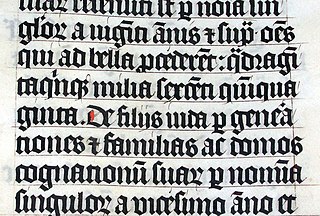
SPQR, an abbreviation for Senatus Populusque Romanus, is an emblematic phrase referring to the government of the Roman Republic. It appears on documents made public by an inscription in stone or metal, in dedications of monuments and public works, and on some Roman currency.

Ibid. is an abbreviation for the Latin word ibīdem, meaning "in the same place", commonly used in an endnote, footnote, bibliography citation, or scholarly reference to refer to the source cited in the preceding note or list item. This is similar to Idem, literally meaning "the same", abbreviated id., which is commonly used in legal citation.
ID or its variants may refer to:

Case citation is a system used by legal professionals to identify past court case decisions, either in series of books called reporters or law reports, or in a neutral style that identifies a decision regardless of where it is reported. Case citations are formatted differently in different jurisdictions, but generally contain the same key information.

The Bluebook: A Uniform System of Citation is a style guide that prescribes the most widely used legal citation system in the United States. It is taught and used at a majority of U.S. law schools and is also used in a majority of federal courts. Legal publishers also use several "house" citation styles in their works. The Bluebook is compiled by the Harvard Law Review Association, the Columbia Law Review, the University of Pennsylvania Law Review, and the Yale Law Journal. Currently, it is in its 21st edition. Its name derives from the cover's color.

Scribal abbreviations or sigla are abbreviations used by ancient and medieval scribes writing in various languages, including Latin, Greek, Old English and Old Norse.
The abbreviation cf. is used in writing to refer the reader to other material to make a comparison with the topic being discussed. Style guides recommend that "cf." be used only to suggest a comparison, and the words "see" or "vide" be used generally to point to a source of information.
Op. cit. is an abbreviation of the Latin phrase opus citatum or opere citato, meaning "the work cited" or in the cited work, respectively.
Supra is an academic and legal citation signal used when a writer desires to refer a reader to an earlier-cited authority.
Some jurisdictions may commit certain types of dangerous sex offenders to state-run detention facilities following the completion of their sentence if that person has a "mental abnormality" or personality disorder that makes the person likely to engage in sexual offenses if not confined in a secure facility. In the United States, twenty states, the federal government, and the District of Columbia have a version of these commitment laws, which are referred to as "Sexually Violent Predator" (SVP) or "Sexually Dangerous Persons" laws.
In botanical nomenclature, author citation is the way of citing the person or group of people who validly published a botanical name, i.e. who first published the name while fulfilling the formal requirements as specified by the International Code of Nomenclature for algae, fungi, and plants (ICN). In cases where a species is no longer in its original generic placement, both the authority for the original genus placement and that for the new combination are given.
Loc. cit. is a footnote or endnote term used to repeat the title and page number for a given work. Loc. cit. is used in place of ibid. when the reference is not only to the work immediately preceding, but also refers to the same page. Therefore, loc. cit. is never followed by volume or page numbers. Loc. cit. may be contrasted with op. cit., in which reference is made to a work previously cited, but to a different page within that work.
Sensu is a Latin word meaning "in the sense of". It is used in a number of fields including biology, geology, linguistics, semiotics, and law. Commonly it refers to how strictly or loosely an expression is used in describing any particular concept, but it also appears in expressions that indicate the convention or context of the usage.
In United States criminal law, the border search exception is a doctrine that allows searches and seizures at international borders and their functional equivalent without a warrant or probable cause. Generally speaking, searches within 100 miles of the border are more permissible without a warrant than those conducted elsewhere in the U.S. The doctrine also allows federal agents to search people at border crossings without a warrant or probable cause. The government is allowed to use scanning devices and to search personal electronics. Invasive bodily searches, however, require reasonable suspicion.
United States v. Martinez-Fuerte, 428 U.S. 543 (1976), was a decision of the United States Supreme Court that allowed the United States Border Patrol to set up permanent or fixed checkpoints on public highways leading to or away from the Mexican border and that the checkpoints are not a violation of the Fourth Amendment.




